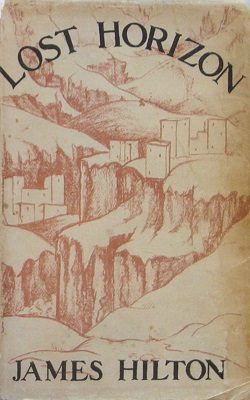Lost Horizon

Dust jacket from the first edition
|
|
| Author | James Hilton |
|---|---|
| Country | United Kingdom |
| Language | English |
| Genre | Fantasy, Non-fiction novel, Adventure novel |
| Publisher | Macmillan |
|
Publication date
|
1933 |
| Media type | Print (hardback & paperback) |
| ISBN | (UK) (US) |
Lost Horizon is a 1933 novel by English writer James Hilton. The book was turned into a movie, also called Lost Horizon, in 1937 by director Frank Capra. It is best remembered as the origin of Shangri-La, a fictional utopian lamasery high in the mountains of Tibet.
Hugh Conway, a veteran member of the British diplomatic service, finds inner peace, love and a sense of purpose in Shangri-La, whose inhabitants enjoy unheard-of longevity. Among the book's themes is an allusion to the possibility of another cataclysmic world war. It is said to have been inspired at least in part by accounts of travels in Tibetan borderlands, published in National Geographic by the explorer and botanist Joseph Rock. The remote communities he visited, such as Muli, show many similarities to the fictional Shangri-La. The town of Zhongdian, has renamed itself Shangri La (Chinese: 香格里拉 Xiānggélǐlā) because of its claim to be the inspiration for the novel.
The book notes that, having made war on the ground, man would fill the skies with death and all precious things were in danger of being lost, like the histories of Rome (Lost books of Livy). It was hoped that, overlooked by the violent, Shangri-la would preserve them and reveal them later to a receptive world exhausted by war. That was the real purpose of the lamasery: study, inner peace and long life were merely a side benefit to living there. Conway is a veteran of the trench warfare of WWI, with the emotional state frequently cited after that war, a sense of emotional exhaustion or accelerated emotional ageing. This harmonises with the existing residents of the lamasery and he is strongly attracted to life at Shangri-La.
...
Wikipedia
